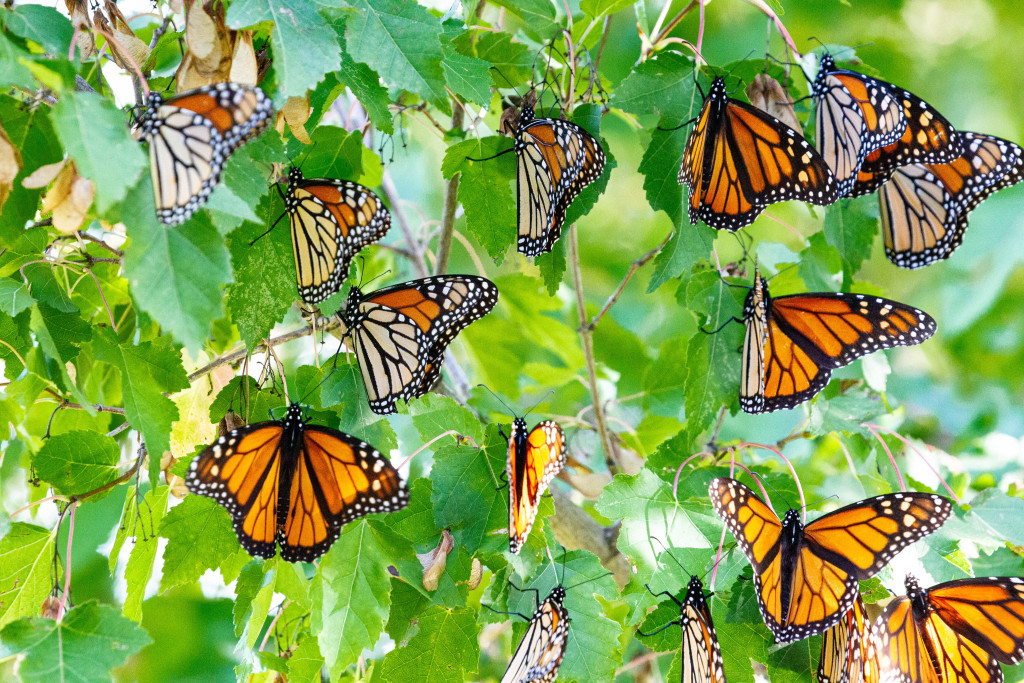
By Monica Macoubrie, Wildlife Education Specialist
For humans, winter means thick, fuzzy blankets, space heaters and hot chocolate to keep ourselves warm during the short, cold days. For many animals, winter is a time of change and adaptability, as temperatures dip and the amount of daylight gets shorter. For example, some animals migrate, some hibernate and others stay active throughout the season. Insects, however, have a few more creative strategies up their sleeves.
Insects are organisms that are exothermic, or cold-blooded, which means they cannot produce their own body heat like humans or birds can. In order to survive and thrive in climates that can be as unforgiving as Nebraska, insects have developed several strategies to deal with frigid weather.
Diapause
In winter, chipmunks and groundhogs tend to hibernate due to the shortage of food and freezing temperatures. Hibernation is thought of as a deep sleep, but it’s actually a biologically distinct state of dormancy. Insects have their own version of this life-saving tool known as diapause.
Insects that are preparing for diapause will eventually try to seek some kind of shelter for the winter, similarly to hibernating mammals. These shelters could be under rocks, in tree trunks, leaf litter or in burrows underground just a few inches beneath your feet. That’s why it’s always a good idea to leave the leaves in your yard, as many animals – not just insects – use these natural materials as insulation in the colder months.
Migration
One approach that many animals, even insects, employ is migration. A classic example is the monarch butterfly, which has one of the most fascinating migratory journeys. Monarchs in Nebraska are known to fly thousands of miles every year to venture to the c Mountains of Mexico to the same areas of the Oyamel Fir Forests. This microclimate is heavenly for these butterflies as temperatures don’t get too hot nor too cold, and the area provides the butterflies the right amount of humidity to live until they can return north in spring. Eventually, the children or grandchildren of last year’s monarchs will return to Nebraska.
Freeze Avoidance
When cold temperatures stay for long periods of time, insects utilize a freeze avoidance strategy. This can be achieved in a few ways. Some species of insects will enter a “dry” hibernation state, when they purge all the food and water in their bodies. This prevents ice inside their bodies from forming, which is deadly. Water requires food or dust particles present in order to crystalize, and thus, water can cool down to -42°C without freezing if these particles are absent.
Other species can produce cryoprotectants, such as glycerol and sugar, to reduce the lethal freezing temperature of their bodies. This concept is similar to the antifreeze found in your car. Many insects use this strategy if they are overwintering as larvae. They also will use the heavy protection of leaf litter or similar shelters to protect themselves, as seen in the woolly bear caterpillar.
Some species of grubs will just burrow deeper into the soil to escape the cold. Some insects have a heavy, waxy coating on their exoskeletons that protects against ice formation.
Overwintering as Nymphs
Not many insects are active in the winter, but the nymphs of dragonflies, mayflies and stoneflies can live under the ice in ponds and streams. These insects actively feed and grow all winter to emerge as adults in early spring. Some of these species may stay in the aquatic larval stage for several years before emerging as adults. There are some species, like the common green darner, that migrate over three generations during the winter, similar to the monarch butterfly.
Overwintering as Eggs
A few insects lay eggs that can survive the winter, such as the praying mantis. Although most adults die out during the late fall and early winter, the females will leave behind a foamy garden ornament on the landscape. This foamy-looking egg case is known as an ootheca, and females will leave them on rocks, twigs, stems or even on the sides of buildings or fences.
After being laid, the ootheca will quickly harden and the mother will die shortly after. These egg cases are normally light brown and look like foam insulation. Inside, the egg case are dozens or hundreds of mantis eggs that can survive the winter due to the foamy insulation. As the weather warms in the spring, young mantids emerge.
In general, insects are best able to survive when temperatures remain fairly stable, and not fluctuating between freezing and thawing. But, just like other creatures, insects can employ a variety of strategies to survive even in the harshest of winters. Whether that is migrating to a warmer location, burrowing deeper into the soil, or creating an egg case for the next generation to survive, we can appreciate the cleverness of insects even during a time of year when we don’t see them.
